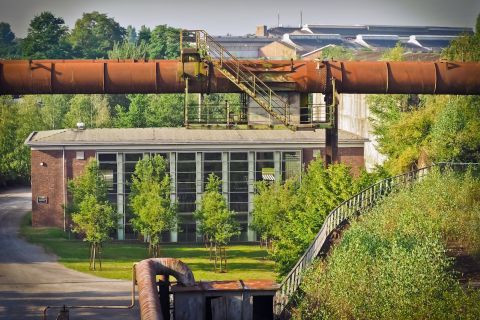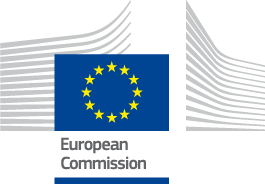
The session discusses how to regenerate Historic Urban Areas in the co-creation of Climate Neutral City Contracts (CCC) for the EU Mission on Cities. A fresh new Policy Report issued by H2020 Innovation Actions CENTRINNO, T-Factor and HUB-IN will be introduced; then policy-makers, city makers and researchers with selected Mission Cities will discuss 3 main operational challenges in CCC (creative spaces; temporary uses; heritage revitalisation) in thematic world-café and peer-learning exercise.
- Urban | Local and regional | Climate and environment | Sustainable | Social inclusion and Equality | Tourism and Heritage | Youth and citizens engagement | Circular economy | Research and Innovation
- Code: 12PL23210
Practical information
- When
-
Thu 12/10/2023, 09:30 - 11:00 CET
- Type of partnership
- NONE
- Format
- Participatory/Political lab
- Theme
-
Regions in post-industrial transition
- Language
- English
- Websites
-
https://centrinno.eu/
https://centrinno.eu/event/eu-regions-week/
https://www.manifattura.milano.it/
- Social media
-
@CentrinnoEU
@CentrinnoEU
@CentrinnoEU
@CentrinnoEU
@CentrinnoEU
@RosalindeEU
@HorizonEU
@t_factor_eu
@t_factor_eu
@t_factor_eu
@t_factor_eu
@ManifatturaMi
@ManifatturaMilano
@Manifattura-Milano
@manifattura_milano
@REA_research
@EUgreenresearch
European Research Executive Agency
@EUHUBIN
@EUHUBIN
@EUHUBIN

Partner

Document
Reporting
Session summary
1. Introduction and Opening messages
By Maria Yeroyanni – DG RTD
First message: Historic cultural cities that contribute to the implementation of the Cities Mission, creating new visions on how urban stakeholders including the citizens, can help the society to collectively imagine what a net zero, regenerative future looks like, becoming the driving force that can move policy from conceptualization to materialisation. The tools delivered by CENTRINO, T-Factor and HUB-IN integrated R&I heritage related knowledge, experience, skills, and showcased that social transformation and inclusiveness, as well as creativity, are at the core of climate transition processes. In fact, the involved cities in the Task Force of these projects evidenced that if these aspects are considered in the process of climate neutrality, they have the potential, to engage and inspire a wide and diverse stakeholder community, including citizens to reimagine a viable, low carbon, just and climate neutral future.
Second message: CENTRINO, T-Factor and HUB-IN consortia and more than 100 stakeholders involved in the implementation of the three projects fully aligned to the Cities Mission objectives and created valuable synergies between all actors and stakeholders at national, regional and EU level. The multi-stakeholder approach in the co-design and co-implementation of solutions is key element for the success of the Mission, which aims to build new avenues of cooperation and collaboration between all stakeholders such as local authorities, researchers, innovators, civil society, practitioners, private sector, developers, and investors. In this way, it is possible to bring real impact for citizens where they are, create benefits for all people in Europe and ensure a successful implementation of the Mission, living no one behind. Cities Mission has a strong citizen engagement dimension, with all participating cities committing to work with their residents directly, so as to ensure that cities are liveable and lovable. The historic and heritage cities selected in the Climate Neutral Cities and involved in the above projects are key contributors to the Mission success to develop ambitious Climate City Contracts.
Third message: Cities Mission leaving no one behind and the National and Regional perspective .
Horizon Europe “Climate-neutral and Smart Cities” Mission aims to deliver 100 climate-neutral and smart cities by 2030 and ensure that these cities act as role models for all European cities to become climate neutral by 2050.
Last year, 100 cities from the EU and 12 additional cities from associated countries were selected (following a call for expression of interest) to take part in this Mission. The cities that were selected come from are all corners of Europe, they are of different sizes and, most of all, they have very different starting points in terms of climate neutrality. All these cities are now working on their Climate City Contracts, which will include their commitments, an action plan and an investment strategy in order to reach climate neutrality by 2030.
12 Climate City Contracts have been submitted to the European Commission and have been reviewed. The Mission Label award to 10 European cities was publicly announced by Executive Vice-president of the European Commission, Maroš Šefčovič, responsible for the European Green Deal, during the session of the European Week of Regions and Cities in Brussels: “Green Deal 2.0: building the future of the European Green Deal together”. The cities are Sonderborg (Denmark), Mannheim (Germany), Madrid, Valencia, Valladolid, Vitoria-Gasteiz and Zaragoza (Spain), Klagenfurt (Austria), Cluj-Napoca (Romania), and Stockholm (Sweden).
In the meantime, a second cohort of cities is preparing the submission of their Climate City Contracts for review by the Commission in the middle of October.
All cities can share technical expertise. Many Mission activities are already open and available to all via the Mission Platform portal. Another opportunity is the Twinning programme based on knowledge sharing and best practices from Pilot Cities to Twin Cities, to broaden the impact of the pilot projects. And all cities can also participate in the calls published in the Cities Mission Work Programme of Horizon Europe. These calls cover many different areas of interests to cities committed to climate neutrality such as urban greening and re-naturing, positive clean energy districts; zero emission urban mobility etc.
2. Policy Recommendations from the joint Policy Report (CENTRINNO, HUB-IN, T- Factor)
#1.Administrative procedures and planning frameworks: Endorse urban strategies and action plans to enable the utilisation of historical buildings and urban areas for innovative and experimental initiatives aimed at preserving and enhancing both tangible and intangible local heritage
#2. Governance structures for multi-stakeholder participation: Establish permanent multi-stakeholder (digital and physical) forums, working groups and participatory decision-making processes that encourage active participation and engagement from all corners of society.
#3. Alternative financing models: Support experimental projects towards inclusive bottom-up innovation and less profitability-based competition, especially in the long-term access to land and public spaces.
#4. Project resilience mechanisms: Introduce flexibility schemes, management mechanisms and pre-defined protocols to deal with uncertainty since the project call (or proposal) phase.
#5. Policy transfer & mainstreaming processes: Support policy transfer and adaptation through peer-exchange mechanisms based on a common repository of best practices.
#6. Knowledge transfer and capacity building: Promote distributed opportunities of lifelong learning and vocational training on innovative skills that are relevant and transferable to a diversity of contexts
#7. Networks of innovation & communities of practice: Create a long-lasting community around the local regeneration process by offering a platform (digital and physical) for different stakeholders to co-design and participate in local development processes.
#8. Advocacy, influence capacity & communication: Provide citizens, stakeholders, and decision-makers with direct access to knowledge, best-practices, and hands-on demonstrators by organising open workshops, residencies, and events with international/high-level guests, to showcase model experiences and success stories.
#9. Impact assessment methods: Establish a common yet adaptable framework for monitoring and evaluating the impact of innovation and entrepreneurship to focus on the qualitative assessment of the transformation achieved, beyond purely quantitative measurement and KPIs.
3. World Café Outcomes
Urban Regeneration and Climate Neutrality – Lisbon
Lisbon's Climate Neutrality Commitment: Lisbon is a signatory of the "Climate-Neutral and Smart Cities Mission by 2030" and is dedicated to achieving climate neutrality by 2030. This commitment sets the stage for innovative strategies.
Regenerating Historic Urban Areas: To attain climate neutrality, Lisbon must intervene in regenerating its historic urban areas and undertake neighbourhood-scale interventions.
Cultural Heritage's Vital Role: The cultural heritage in historic urban areas, encompassing both physical heritage and intangible cultural value, is crucial for successful regeneration efforts.
Tailored Approaches for Historic Neighbourhoods: Achieving climate neutrality in historic urban areas requires tailored, fine-grained approaches that consider the unique challenges of these neighbourhoods.
Unique Challenges of Historic Neighbourhoods: Historic neighbourhoods face distinct challenges such as increased tourism, gentrification, population loss, public space degradation, and abandonment of historical buildings and infrastructure.
HUB-IN Pilot Project: The HUB-IN pilot project in Lisbon exemplifies an approach that combines heritage-driven innovation to address renewable energy barriers, short food cycles, and climate resilience. This project includes a Knowledge Sharing Community and a Sprout Tank Experimental Program for incubating circular economy ideas.
Local Dialogue and Collaboration: The success of culture-led urban regeneration for climate action relies on fostering local dialogue and collaboration to ensure community engagement and support.
Sustainable Practices: Implementing sustainable practices in these areas, such as renewable energy solutions, circular economy concepts, and green infrastructure, is critical for achieving climate neutrality.
Community Involvement: Engaging and empowering local communities in the regeneration process is key to preserving cultural heritage and building climate resilience.
Cultural Value and Identity: Emphasizing the preservation of cultural value and identity in historic areas is a driving force behind the synergy of culture-led regeneration and climate action
Circular Cities & Cultural Heritage – Milan
The table has discussed on the opportunities to leverage on the material and immaterial heritage available locally in the urban context to build up and sustain circular economy practices. The main challenge is the loss of industrial knowledge, capacity and heritage and the related human capital, fuelled by an increasing lack of manufacturing jobs. The phasing out of industrial practices is also leading to the modification of the fabric and landscape with an increasing need (opportunity) to regenerate vacant spaces. The objective of Milan (and more European cities in CENTRINNO) is to tap into the local industrial heritage and valorise as an inspiration for contemporary development towards Circular Economy.
The route to activating local circular economy production strongly depends on the creation of a stakeholder community, which self-aliments engagement and commitment around similar strategic visions and objectives. Policy instruments such as the Air and Climate Pact in Milan, and especially the Climate City Contracts in the framework of the EU Mission Cities, are an effective way to involve and commit stakeholders in urban regeneration activities.
The participants discussed on concrete possibilities to revamp industrial heritage into circular production. Milan has adopted strategies to attract craftmanship back into the city, while adopting a circular economy plan specifically for fashion and design, two among the top industrial sectors already active in the city. Zagreb has adopted a scheme of grants and subsidies reserved for SMEs with focus on young entrepreneurs. With examples from Belgium, the participants also reflected on the importance of introducing circular value chains in cultural entrepreneurship. Across different experiences there is consensus that administrative and regulatory procedures still represent a hindering factor. Formally incorporating cultural and industrial heritage aspects into policy frameworks and actions plans would contribute overcoming such operational challenges.
Climate Neutral and Circular Cities – Dortmund
The table agreed that to achieve circular economy (CE) in cities we need to embrace a cultural shift that is supported by consideration on economic sustainability of CE’s actions. CE might appear desirable as policy goal but, while pursuing it, we should be reminded of the broader EU’s framework of commerce, in which most goods are imported by non-member states (note: according to one of the participants at the table). This state of things makes difficult to create CE actions that are competitive in economic terms: it is always easier to follow the “old”, non-circular model. Cities can achieve innovative CE actions only by considering this wider picture and ensuring that it is accompanied with economic sustainability strategy. Two specific challenges in this sense are: 1) going beyond a business model based on volume of produced goods; 2) to close the link between producers. and the consumer.
The topic of “long-term governance” appeared relevant to the table’s participants, because CE actions in cities must be sustained for a prolonged period. Cities must ensure that CE’s initiatives can survive after the initial support given, and this implies that stakeholders are engaged with long-term motivation. One challenge is to match the timeframe of businesses embarking in CE actions, who usually expect short term delivery for profit-maximization, and the long-term perspective of cities, that instead look at years-long policy goals and social impact outcomes. The table’s participants agree that private companies are slowly changing perspective because of the new awareness about SDGs. On the cities’ side, it is important that new governance and policy tools reflects this shift and are ready to welcome it.
The participants pointed to some relevant examples that saw European cities developing a virtuous model of market-/social innovation, rooted in existing cultures of industrial production. For example, the city of Prato in Tuscany, developed the Prato Circular City initiative, addressing the topic of circularity while involving textile industries that traditionally operate in that territory. These industries are now experiment with some innovation in production (sustainable textile) and could connect with Prato Circular City. Ultimately, Prato Circular City could drive actions connected with circularity but also engage citizens with collective reforestation.
4. Key messages and closing remarks
By Arnoldas Milukas – EC REA
Key messages
Overall message: REA, the European Research Executive Agency of the European Commission, is strongly committed to support high quality EU Research and Innovation and enhance the impact of Horizon projects. The successful implementation of the projects managed in REA has a striking potential to benefit cities, citizens and contribute to future EU policies. The excellent results achieved by CENTRINNO, HUB-IN and T-Factor -managed in REA - over almost 3 years are a clear example of the effectiveness of this approach.
First message: REA actively supported CENTRINNO, HUB-IN, and T-Factor projects in their paths to co-create solutions with citizens and stakeholders, in line with the EU approach to Open Innovation. Results are impressive: the 3 projects extensively engaged with communities, neighbourhoods, companies and SMEs in 26 cities that are directly participating in the cluster. Additional 20 cities are being added, all striving to create an empowered network of 46 Hubs of Innovation across Europe. These hubs aim to enhance historic urban districts in Europe, making them more inclusive, creative, and innovative through practical solutions co-created with the 3 projects.
Second message: REA advised the 3 projects in their clustering journey, fostering the exchanging of ideas, knowledge sharing and cross-learning activities. Over nearly three years of collaboration, the 3 projects were able to find a common thread from the diversity of cities and cases involved, amplifying the wide array of local experiences and creating a critical mass of experiences. The results of this substantial collaboration are remarkable, with actionable recommendations that are currently being used in the involved cities – as in the cases of Lisbon, Milan and Dortmund - and that can serve as a blueprint for numerous European cities, transcending their original contexts.
Third message: The collaboration of the 3 projects was pivotal for the feedback to EU policies, another aspect that is taken very seriously in REA. The 3 projects collaboration came at a key moment in the implementation of the EU Missions on Climate Neutral and Smart Cities. CENTRINNO, HUB-IN and T-Factor unique perspective of achieving climate neutrality and environmental targets while preserving cultural and historical heritage resonated with the importance of addressing environmental, cultural, and social targets systematically and inclusively. By showing that societal transformation and inclusiveness, as well as culture and creativity, are core elements of the climate transition, the projects are offering a new and innovative approach that can effectively contribute to future EU policies and inspire numerous regions, cities, and communities.
Quotes
-
The EU Mission cities represent a new collaborative initiative between EU institutions and actively participating cities. Leveraging culture and heritage as resources, Mission Cities can drive climate neutrality and foster trust and inclusivity.
International networking and knowledge-sharing are pivotal for the sustainable urban regeneration processes in historic urban areas. This forms the primary mission of the Cluster of Innovative HUBs, and the 26 cities it engages with the 3 Sister Projects
Evidence from pilots shows the great contribution that hubs of innovation can bring to the green and digital transition, towards the achievement of climate neutrality in line with the principles and objectives of the City Missions
Joint Clustering Activities represented a unique opportunity to experiment and scale up transformative regeneration processes across a diversity of geographies, cultures, socio-cultural capitals, and connotations of heritage that make EU cities unique.
Dortmund and the Ruhr Region had to master various structural and economic transformation processes in the past decades. The transformation from a linear to a circular economy will benefit from previously established mindset and governance experience.
Lisbon is committed to becoming a carbon-neutral city by 2030. This process involves the city, businesses, local actors, and citizens. Projects like HUB-IN are fully aligned with the climate policy of a just and inclusive transition.
Milan has a storied history of manufacturing, which has played a pivotal role in shaping its identity over the years, and now we are building on this heritage and tradition as a source of inspiration and innovation to drive the shift towards circularity.
REA is highly committed to enhance the impact of EU R&I, supporting collaborative activities and open innovation in Horizon projects. Results from CENTRINNO, HUB-IN and T-Factor are clearly benefitting cities and citizens and contribute to EU policymaking
Participation, co-governance and citizen involvement are key to moving towards resilient cities and climate neutrality. Increasing the role of cultural heritage and historic urban areas is pivotal to achieve these goals
Additional links
https://centrinno.eu/blog/policy-report/
https://netzerocities.eu/mission-cities/
https://www.comune.milano.it/aree-tematiche/ambiente/aria-e-clima/piano-aria-clima
https://www.wirtschaftsfoerderung-dortmund.de/dozirkulaer2030



